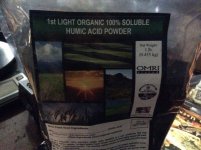O
OptionDork
Are you referring to a whole humate product like HumaCarb or something like an extract?So what's the advantage of a non-chelated humic acid product over one that's already chelated, assuming we're talking about "best" product? Not necessarily the most affordable, but it keeps you from playing a guessing game in regards to available mineral content in your soil.
Honestly guys my research into humic/fulvic acids is about 4 years old and never kept up.
Kind of weird they have a slew of test results except one for humic acid content. On the A & L test report there's a remark stating 'Humic Acid (A&L) = 95%' yet nothing noted above under each compound/element/mineral. If potash % as K20 is 18.96 and N at 1.28 % how can the product be 95% humic acid? Very rusty yet guessing the K comes from potassium hydroxide as most use the acid/alkaline extraction method so companies are actually producing humic salts.[FONT=Arial, Helvetica, sans-serif] How about this HA product? Thoughts & opinions? It sure looks cool when you sprinkle a little in a clear glass of water as it slowly disperses downward.[/FONT]
I did get a copy of an A&L report for humic acid content of HumaCarb yet have lost track of it. This is a specific report which shows the actual %. If I'm remembering correctly there are 2 methods of analysis for humic acid. One will provide a much higher result than the other. One will include things like waxes and stuff which inflate the value of humic acid.
Another thing is when I was working on my project I did talk to A&L about testing for fulvic acid and they said there is no legitimate test and if I could find a good method they'd like to have it. So Diamond Grow claims their product contains fulvic acid (how much?) yet A&L can't even test for it?
Going back to the typical acid/alkaline extraction method I've been told it denatures humic acid. Are you buying humic acid or humic salts? Changes in pH actually change the molecular structure of humic acid like it's almost alive.
Supposedly A&L said HumaCarb had the highest concentration of humic acid they've ever seen.





